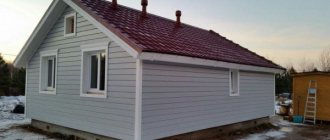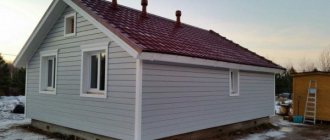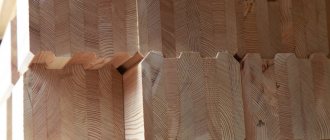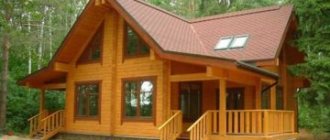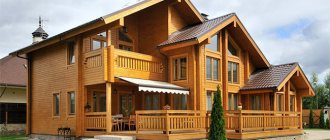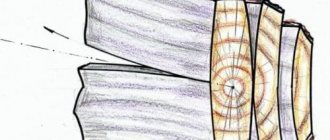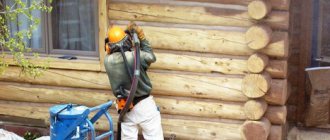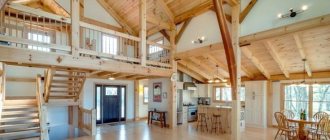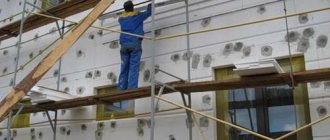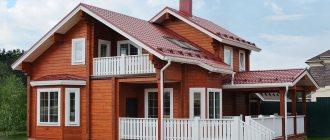A house made of laminated veneer lumber will not lose its attractiveness over a long period of operation, thanks to the correct choice of paint for facade work. Painting your walls beautifully is an important task, but highlighting the visible grain of the wood is just as important. This method of coloring is called glaze. Special oil-based antiseptics not only do not hide the pattern, but are also designed to protect the external walls of a timber structure from negative atmospheric influences (rain, wind, sunlight, low temperatures). The construction market offers a large selection of paints and varnishes, which are worth discussing in more detail.
When is it necessary to paint the outside of a laminated timber house?
- First of all, the main task of paintwork is to increase the attractiveness of the surface being treated. In the case of a wooden wall, you can easily emphasize the natural beauty of the material, since cut wood already looks quite aesthetically pleasing.
- Wood darkens over time, and sooner or later its texture will have to be masked. For this purpose, compositions with greater hiding power are used to hide the pattern on the surface.
- Painting compositions, impregnations and mastics help protect wood from the negative influences of the external environment. The time of preservation of natural beauty depends on the level of protection.
- In addition, preventing wood from coming into contact with microorganisms and moisture has a positive effect on its performance characteristics: a well-painted house retains its load-bearing capacity longer and does not rot.
- Another factor that negatively affects the condition of the timber is UV radiation. UV filters, namely the substances that make up most modern paints, help protect against it.
As you can see, there are many arguments in favor of painting the outside of a laminated timber house. Now you need to decide on the type of painting and the best technology for applying it.
What to choose for painting?
Compositions for internal use
The main purpose of interior paint is to give wooden walls an aesthetic appearance. Maximum protection is required inside the house, for this reason we recommend focusing not on the decorations.
In terms of materials that can be used to process timber walls inside, experts advise using:
- Impregnating compounds - waxes, drying oils, wood oils, etc. All these products do not form films on the surface of the wood, for this reason the appearance of the wall is practically unchanged. At the same time, the texture of natural wood and the contrast of the fibers are emphasized.
- Mastics - maintain the velvety surface, and also highlight the pattern on the cut of the timber. Moreover, mastic allows you to mask small chips and cracks.
- Varnishes (matte and glossy) are the most common compositions used for interior decoration. Typically, a varnish with a tinting component is applied to the base, and then several translucent layers are laid. As a result, the surface receives additional “depth”. Varnish is primarily useful where the timber wall is most exposed to friction, for example, along the stairs.
- Interior paints. Painting wood inside a house can be done with compositions with different covering power, depending on what kind of task they are faced with. If you want to preserve the natural pattern of wood, then glaze acrylic compounds are used. If it is necessary to give the wall a new color, then an alkyd or acrylic-based covering paint is used.
Almost the same paint and varnish materials are used to treat a wide variety of wooden components inside the house. Thus, painting imitation timber or clapboard cladding indoors can be done with the same acrylic varnishes or paints as used for processing timber.
conclusions
- Long-term and beautiful wood coating is only possible on properly prepared wood.
- If you do not want to hide the structure of the wood, choose covering paints.
- The product used for antiseptic must be combined with varnish, paint or oil. Do not apply paints based on natural oils to compounds that form a polymer film, or oils to water-based antiseptics.
- Antiseptics, azures and oils are most often applied with brushes (dense packing is important, wax must be natural or mixed).
- The most important condition is to follow all the manufacturer’s recommendations for the formation of paintwork.
At FORUMHOUSE all the nuances of processing and painting a wooden house are discussed, join the discussion.
Painting the outside of a laminated timber house: varnishes, paints and impregnations
External processing of laminated veneer lumber is primarily aimed at protecting the house from the effects of negative environmental factors, as well as changing its appearance.
Analysis of compounds used for processing:
- Organic or water based impregnations. They are not actually paints as they have little effect on the appearance of the home. Their main function is damage by microorganisms, protection from fire, etc.
- Film-forming compositions (can be either opaque or translucent). They protect the wood from contact with moisture, but do not prevent the evaporation of liquid from the thickness of the wood.
- Coloring antiseptics are compositions that are intended for external treatment of timber houses.
- Exterior paints. In terms of characteristics, they are close to film-forming compositions, but their main function is to change the color of the surface. Although painting the outside of a timber house using paints from leading manufacturers often replaces protective treatment.
Popular paints for the facade of laminated timber houses
Houses made of laminated veneer lumber look very attractive, but every year their appearance deteriorates. This happens under the negative influence of the environment. Decorative painting allows you to solve this problem. Proper painting of walls includes a set of actions that we will discuss below.
The color of the coating is chosen in strict accordance with the design of the house. Contrasting tinting will highlight the natural pattern and emphasize the structure of the wood. Paints will add richness to the walls and cover up the wood. But the final choice always depends on the residents of the house. Whatever color you choose for a house made of laminated veneer lumber, it must meet the main requirements.
- German. Paints of this brand are produced on the basis of water, which means they are highly environmentally friendly. They are conveniently applied to a wooden base; such material retains heat for a long time. Paint and varnish materials are presented in a wide range. The cost is in the average range. A significant drawback is the need to regularly update the coverage (every five years).
- German. The material is oil-based and therefore does not cause harm to human health. Perfectly emphasizes the structure of wood and is easy to apply. Retains its original shade for a long time and does not require regular updating. It is often used for interior and exterior work. Its main drawback is its unreasonably high price.
- Finnish. It’s worth saying right away that the paints of this company are presented in a rich assortment. Among the advantages, it is worth highlighting the low cost, high color fastness and pleasant color; among the disadvantages is the need for constant updating - approximately every 5 years.
- Domestic. Paints are offered in a wide range and at an affordable price. They retain their original color for many years, but require regular touch-up (at least once every five years).
- Domestic paints "Termika". The coatings are highly resistant to temperature changes, ultraviolet rays and moisture, and are perfect for painting the outside of laminated timber houses. The prices are quite reasonable, but the assortment leaves much to be desired.
Exterior painting of laminated timber walls
Proper preparation is the key to effective results.
Glued laminated timber is a material with excellent performance characteristics. It is almost not deformed during shrinkage, and yet it is necessary to process or paint it in another way only if certain rules are strictly observed.
Attention! Experts advise starting work no later than 3 months after the construction of buildings. If you allow the house to stand longer, the timber will gradually begin to deteriorate under the influence of climatic factors, which will negatively affect the adhesion of paint to wood.
To properly prepare the surface for painting, here are the instructions:
- Painting is carried out at a temperature of at least +5 degrees. As for interior work, humidity should be no more than 80%.
- To improve the adhesion of paint to the surface of the timber, all painted surfaces must be plastered and sanded.
Attention! After sanding, you need to “walk” over the walls using an industrial vacuum cleaner. The joints of the beams deserve special attention, since this is where most of the small sawdust, as well as wood dust, accumulates.
- We apply a special sealant to the ends of the beams.
- Primer for sanded surfaces. Typically, the price of primer compositions is low, but they provide high-quality paint adhesion. Therefore, it is better to spend money on a primer and save on buying expensive enamel or acrylic compounds.
- Paint can be applied only after the primer has completely dried.
As for the technology of external and internal processing of timber walls, it is almost no different. The only difference is the number of layers of material that is applied to the base.
If you plan to do the painting yourself, follow these tips:
- Paints must be mixed according to the manufacturer's instructions. The situation is exactly the same with varnishes with tinting components.
- Prepare a clean and large container for mixing.
- Before starting work, test the composition by using it on a small area. This way you will get an idea of the appearance of the wall.
Attention! This must be done, since the color of the wood greatly influences the final result. Therefore, test coloring allows you to make adjustments and, possibly, reduce or increase the amount of pigment.
- To apply paint, use a roller, brush or spray. It is recommended to apply varnishing using a brush.
- First, we apply the first layer of material to the wood flooring. The smaller its thickness, the better.
- After it dries, we continue painting. To process timber walls, you may need from 3 to 5 layers of material. All of them can be applied only after the previous one has dried.
After finishing painting, you need to wait until the walls dry. After 1-2 months, you should carefully inspect the surfaces and, if necessary, seal any cracks and crevices with sealant. Apply paint over the sealant, following the same technology as when painting a house.
Some tips for painting the outside of a laminated timber house
To paint the facade of a wooden house, you need to carry out preparatory measures and adhere to some rules. We will provide some tips below.
- Before painting, the surface must be thoroughly cleaned of dust and dirt with a brush. This work is best done using water. To do this, use a garden sprayer and a medium-hard brush, which are convenient for removing dirt from the surface.
- Get rid of mold with special solutions. There are a lot of them on sale. To find mold, simply inspect the walls for gray-blue stains.
- To get rid of tree resin, you should use a metal spatula. After you remove the resin, only a small hole will remain, which can be sealed with varnish.
- If nails or other metal elements protrude from the surface, they must be treated with compounds that prevent corrosion.
- After all preparatory measures have been completed, the wood is allowed to dry. This process may take approximately 2 weeks. To protect the material, you will need to cover the structure with plastic film, which has holes for ventilation.
How much does it cost to paint a laminated timber house?
Of course, you can paint the house yourself by studying our material and reading the photos, but this will take a lot of time and effort, especially if you have a large cottage. Therefore, most people still resort to the services of professionals.
The cost of painting laminated timber walls depends on the following factors:
- prices of materials used;
- worker qualifications;
- type of work required.
We present you the average cost of coloring services in our country in the form of a table:
| Types of services | Price in rubles | Per m2 |
| Sanding walls and other surfaces of laminated timber | 120-160 | |
| Antiseptic | 80-90 | |
| Painting laminated veneer lumber (roof overhangs, walls, beams, pillars, front board) in one layer | 90-100 | |
| Removing lint from timber walls | 40-50 | |
| Processing the ends of the timber (sealing and grinding). | 360-400 | Per linear m |
| Painting of platbands (including dismantling and installation). | 140-150 | |
| Painting fencing of terraces and balconies | 700-800 |
The desire to embellish and also protect your house, built from laminated veneer lumber, is completely justified. Such a building will not be cheap, which means it will be built to last for many years. Moreover, the decor and coloring of the walls will give your home individuality and express your fantasies and dreams. Agree, this is important!
Conclusion
Interior and exterior painting of a timber house is a must if you want to add durability to the building. Despite the fact that laminated veneer lumber is quite easy to paint, it is worth following some recommendations. In this case, the paint will have to be updated less often, and the appearance of the house will be much better.
Dyeing technology
Both the external and internal painting of the walls has almost no differences. The only difference is that when painting externally, the profiled timber is treated with several layers of coloring composition.
Article on the topic: Which sauna is better, made of timber or blocks?
If you decide to paint the external laminated veneer lumber yourself, then before you start doing the work, you need to decide what to paint the surface of the external walls with. In addition, you should follow some tips:
- the paint must be mixed in strict compliance with the instructions specified by the manufacturer. This rule also applies to varnish with tinting components. Mixing the compositions should be carried out in a large and clean container;
- Before you start painting, you need to test the composition on a small area of the surface. This is done in order to find out what appearance the wall will acquire after painting;
- painting is done using a roller, spray or brush. It is better to apply varnish using brushes;
- To completely treat the surface of laminated timber, it is necessary to apply up to five layers. Each layer is applied only after the previous one has completely dried.
Painting a house made of laminated veneer lumber: choosing paint coatings and how to paint correctly?
Wood has many advantages over other building materials, since it is natural. Thanks to this, a house built of wood maintains a special microclimate at any time of the year: it is easy to breathe, cool in the heat, and warm and cozy in winter. Modern wood processing technologies provide a wide selection of building materials that are not inferior in strength and durability to brick and concrete. Glued laminated timber is gaining great popularity among all types of new generation materials. Distinctive features of this material are: super strength, good thermal insulation abilities and high constructability.
Having a smooth surface, laminated veneer lumber does not require additional decorative finishing during construction. But in order to preserve the original properties of wood and protect its appearance from the effects of natural conditions, it must be treated with a special antiseptic coating. It is advisable to paint a house made of timber as soon as possible, without leaving untreated material before winter or for the next season. In this case, it is possible to protect wooden surfaces from moisture, mold and rot. It is advisable to obtain recommendations on choosing a suitable product from a qualified specialist; he will advise which coatings are best to use for external or internal work indoors.
Types of paint and varnish coatings
At the moment, there are two types of coatings: impregnating and film-forming antiseptics. Impregnating coatings, in turn, are divided into two subtypes:
- water based;
- on an organic basis.
Water-based antiseptics easily penetrate into the wood and do not have a specific odor - while the wood retains its natural properties. Organic-based impregnation also has good penetrating properties. This product contains various valuable additives that are intended to prevent and combat mold and mildew. Film-forming coatings are divided into:
- transparent compounds (so-called glazing);
- opaque.
The glaze composition is more transparent, which allows you to preserve the original appearance of the wood structure. The final color of the future surface depends on the quality of the wood, its species and the original color. The number of coating layers applied also affects the final color of the surface. When choosing such a composition, you need to keep in mind that over time it is washed out by water under the influence of the environment and will therefore require repeated surface renewal.
Opaque (opaque) compounds are similar to paint. They completely cover the wood and, after drying, a film is formed on the surface of the material, protecting the laminated veneer lumber from fungus, mold and moisture. Also, resistant to atmospheric conditions and ultraviolet rays. At the same time, thanks to a very thin layer of film, the properties of the wood are not lost.
Features of the harmful effects of the environment
It is recommended to paint wood due to the need to protect the surface from many harmful natural factors to which the façade of a house is constantly exposed. The following impacts can be identified:
- Water has a destructive effect on a wooden structure; over time, the material becomes covered with unsightly stains and stains appear. The result will be darkening and deterioration of integrity;
- Ultraviolet radiation also leads to a change in surface color;
- Insects and pests destroy the tree;
- Humidity can lead to biological formations.
You need to move on to coloring faster; usually you can wait no more than 3-4 months.
It is recommended to paint wood due to the need to protect the surface from many harmful natural factors to which the façade of a house is constantly exposed.
Painting process
Before starting work, it is recommended to read the instructions located on the packaging of the products used. There must be enough paint to cover the entire surface, otherwise when repainting the color will differ from the original. The surface prepared for painting must be dry. Painting should be carried out at a temperature not lower than +5̊ C; you cannot paint in the evening - evening dew will spoil the quality of the coating. Various oils, mastics and paints and varnishes are used to treat wooden surfaces indoors. Based on drying oil and linseed oil, they are harmless to human health. Oil gives the surface a beautiful shade, while at the same time preserving the unique grain of the wood. But this is not enough for high-quality processing, because the proposed products cannot cope with dampness and dirt. If an appropriate microclimate is maintained in the room, then the walls inside the house will be less susceptible to fungus or mold. Natural mastics help hide wood imperfections, figuratively “removing” defects. Mastic gives the surface a matte appearance, while protecting it from dampness and various contaminants. The disadvantage of using mastic can be considered the labor intensity when processing wooden surfaces. Another disadvantage is that after its use, the wood stops “breathing”.
Various types of varnishes are widely used to protect wood:
- Acrylic;
- Alkyd;
- Polyurethane.
Painted surfaces, depending on the paint coating used, acquire a glossy, semi-matte or matte appearance. The wood receives good protection from mold and dampness. Under such a coating you can hide possible defects. Also, they are not afraid of wet cleaning - you can simply wash them. The tree retains all its properties. The disadvantage of using varnish is its toxicity during painting. But after drying, paints and varnishes become harmless to others.
More interesting articles on our website https://www.dom-brus.com
Paint application methods
There are several ways to apply the compositions, but the masters decide which one to choose:
- Hand painting. Paint brushes are used to apply paint. But achieving high quality coating will be difficult if the surface is uneven.
- Mechanical painting. The use of spray guns and sprayers significantly reduces operating time and reduces material consumption. It is rational to use this method over a large treated area and with limited time.
Why paint laminated timber?
Despite the use of an adhesive base, the material is breathable and “living”. This means that the surface after construction of a house made of timber is afraid of direct sunlight, moisture and temperature changes. Painting the surface with various protective agents will save the owner from further forced repairs.
For protection, special primers are used - antiseptics, which will prevent the appearance of fungi and mold. And in the second stage, a layer of protection from direct sunlight is applied.
It is also important how the walls will look, which is why both glazing and matte covering compositions are used.
Products for covering a house made of laminated timber
House made of laminated veneer lumber, painted with glazing compounds
There is no point in delaying painting a house made of laminated veneer lumber. You need to paint it right away, and it’s better to soak it with antiseptics for the first time before assembling. Various compositions of domestic and imported production are sold for coating.
But not all of them have the appropriate quality; experts recommend using Osmo, Sikkens (AkzoNobel), Tikkurilla products. If painting is done correctly, it will need to be repainted no earlier than after 4-5 years.
The qualitative characteristics of some of them can be seen in the table:
| Manufacturers | pros | Minuses | price, rub. |
| Sikkens (AkzoNobel) (German manufacturer) | They produce a water-based coating, do not fade in direct sunlight, excellent adhesion, many color options, low cost. | You need to constantly monitor it, because after 5-6 years it begins to peel off. | From 120 l. |
| Osmo (German manufacturer) | There are both water-based and oil-based coatings that do not fade over time, protect the wood from destruction, and are easy to clean. | The price is high | From 320 l. |
| Tikkurila (Finnish production) | An assortment of more than 35 colors, there are formulations based on natural oils and water, does not fade in the sun, and a reasonable price. | It will have to be repainted after 3-4 years. | From 150 l. |
| Marshal (Russia, Moscow) | Low cost, does not fade under the sun, a wide range of paint and varnish coatings. | Not durable, repainting will have to be done every 2-3 years, slight coloring. | From 100 l. |
| Finncolor (Russia, subsidiary of Tikkurila) | The assortment of flowers is more than 35, many different varieties, including water and natural oil, low cost. | You will have to update it every 3-4 years. | From 120 l. |
When choosing a coating composition after completing the construction of a house made of laminated veneer lumber, you need to focus on a number of factors:
- External or internal coating. (There are universal products that are used both outdoors and in the house, but it is better to use separate ones, since the main function of the internal one is decorative, and the external one is protective).
- The appearance of the walls (whether the owner wants to preserve the natural pattern and texture or not).
- What effect do you want to get (protection, or to emphasize beauty, or both at once).
For laminated veneer lumber, two types of coatings are used: film-forming and impregnating.
Impregnating compositions
Impregnation of a house made of laminated veneer lumber
Impregnating antiseptics can be divided according to their composition:
- Water based
- Organic based.
Impregnations - water-based antiseptics do not have a strong odor and easily penetrate the wood. The timber after such coating will not lose its quality characteristics. Water-based impregnations are used mainly indoors.
Organic-based impregnations contain various impurities that help prevent the development of mold and mildew. But they may have a specific smell, so these are mainly for external work.
Coating film compositions
These can be divided into transparent and matte. Transparent ones include glazes, which do not hide the wood, but only emphasize its texture and pattern. When coating, the shade may change slightly, but this depends on the number of layers applied, the species and the natural color.
Matte ones will hide the appearance of the wood and give the house the chosen color. These are rarely used for laminated veneer lumber, since the material itself has a noble and beautiful surface.
Wood protection
Really high-quality laminated veneer lumber can last for decades, but it still remains wood, which is susceptible to the influence of many environmental factors, and therefore requires protective measures. The service life of this material can be significantly reduced by:
Houses made of laminated veneer lumber are a real breakthrough in construction. By following the link https://vse-postroim-sami.ru/materials/lumber/6163_klej-dlya-kleenogo-brusa-naskolko-ekologichny-doma-iz-kleenogo-brusa/, you will learn about glue for laminated veneer lumber. This article contains information about the new protective paint.
Water. It gets into the pores of the wood, causing it to swell, crack, or rot inside. To protect against moisture, a sealant is usually used, which is used to impregnate the ends of the laminated veneer lumber. This consumable clogs the wood pores, preventing liquid from entering them.
Fungi or mold. Wood is a favorite breeding ground for various types of mold and fungi, which subsequently significantly reduce its service life. To prevent this problem, apply a layer of antiseptic primer.
Sun rays. Ultraviolet rays have a detrimental effect on any wood, and laminated veneer lumber is no exception. The fact is that this material contains lignin, which darkens under the influence of ultraviolet forms. Special sunscreen compounds will help cope with this problem.
Applying paint to laminated timber
Return to content
Subtleties of painting a house
All painting takes place in several main stages:
- Sanding the surface of the walls. Even after building a house from profiled timber, the sanded timber must be passed through in one layer with the finest nozzle. During construction, the walls will still get dirty and, without sanding, the paint will lie unevenly.
- Applying a primer is an antiseptic. It will prevent the appearance of mold and fungi and increase the adhesion of paint to the timber.
- Painting. Varnish or paint is applied in several layers. Moreover, each subsequent one is applied only after the previous one has dried.
When painting, it is important to carefully treat the ends of the timber. If the ends are not sealed, moisture will easily penetrate inside through the capillaries. To do this, use all possible sealants, the cheapest of which is liquid glass. To enhance the effect, you can tap the ends with a rubber hammer before painting. But you need to be careful, as the slats may come apart.
Before painting, it is important to study the instructions for use and correctly calculate the paint consumption. It is better to purchase a little more, since even from the same manufacturer there may be a slight difference in shade in different batches.
It is not recommended to paint outdoors in damp weather and at temperatures less than +5 degrees. The surface of the timber must be cleaned of dust and sanded. It is not recommended to paint outside in the evening, as dew will ruin the surface.
To treat interior walls, oils and mastics based on natural oil or water are mainly used. But they are not sufficient to protect against moisture and dirt, but there are enough of them inside the house. The walls are coated with glossy or matte varnish on top.
If you don’t have the opportunity or skill to paint the walls yourself, then it’s better to turn to specialists.
How much does it cost to paint walls
The cost of painting laminated timber depends on:
- Dimensions of the area to be painted.
- Whether preliminary preparation is necessary or not.
- Work team qualifications.
The average cost for basic work can be seen in the table:
| Works | Price, rubles | |
| Sanding walls before coating | 130-200 | per m2 |
| Antiseptic coating | 80-90 | |
| Painting walls in 1 layer | 90-150 | |
| Removing lint from the surface | 40-60 | |
| Grinding and sealing ends | 400-550 | Per linear m |
| Painting | 170-230 | |
| Painting extensions such as verandas or balconies | 500-750 | |
Building a house from laminated veneer lumber is not a cheap pleasure. This means that he must have adequate protection. You need to choose high-quality and expensive coverage.
Basic requirements for painting work
There are certain requirements for painting houses made of laminated veneer lumber:
- Primer and paint are applied only to a carefully prepared surface. There should be no dust or oily areas.
- Be sure to create several layers, which will improve the quality of painting.
- You cannot carry out tinting work at home in several stages, which have a long break in time. Even after several weeks or months, the already treated areas of the wall may differ significantly in shade from the freshly applied layer. This happens when choosing paint that is exposed to ultraviolet radiation.
- Painting work is contraindicated in high air humidity. The reasons for poor-quality processing are poor adhesion and the appearance of defects on wet wood. All these factors reduce the service life of wood flooring. Therefore, before starting painting, the surface humidity is checked.
- 3 months after completion of construction work, walls, window and door openings are sealed. In this connection, the season for painting a house made of laminated veneer lumber most often falls in late spring or early summer. If you can’t start work during this period, then you need to have time to paint the walls before the temperature drops. Work is carried out in conditions not lower than +5°C.
Just the desire to make your home beautiful is not enough; you need to find craftsmen who can do everything efficiently. Houses made of laminated veneer lumber are expensive, so the owner’s task is to maximize the service life. Only professionals can cope with the task and guarantee the durability of painted walls.
